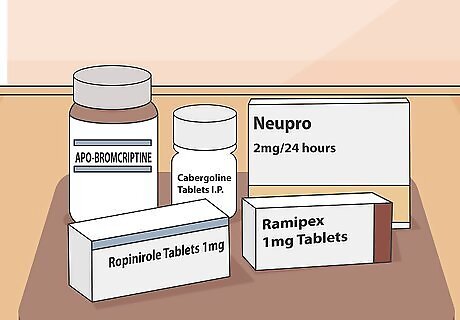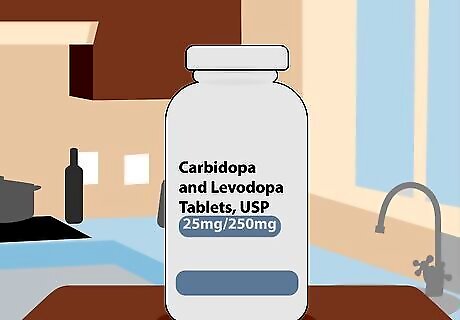
views
Making Gradual Lifestyle Changes

Talk to your doctor about your concerns regarding dopamine receptors. Medical knowledge about dopamine and dopamine receptors has grown exponentially since the existence of receptors was first proven in 1972. That said, there’s still a great deal to be learned. To get the most up-to-date information, start by having a conversation with your doctor. In some cases, your doctor may want to do testing to determine if you have low dopamine levels and/or underactive dopamine receptors. These may include a physical examination, blood tests, and questions about any symptoms you’re experiencing, among others.

Discuss whether gradual lifestyle changes may benefit you. If your doctor suspects that you may have a problem with underactive dopamine receptors, it’s possible they may recommend a gradual process to slowly “retrain” and “reactivate” the receptors. In theory, making gradual changes may re-wire your receptors to trigger sensations of both reward and motivation for active and healthy behaviors. There’s a lot of uncertainty and theorizing here, but you might sum it up by the difference between making a New Year’s resolution to exercise more and eat healthy all at once, versus aiming to make incremental improvements over a longer period of time. In the latter case, your dopamine receptors may be more capable of being retrained and/or reactivated. Even if your doctor doesn’t think you need to worry about your dopamine receptors, they’ll surely be on board with any plans you have to gradually make healthy lifestyle changes.

Adjust to a low-fat, reduced-calorie diet over time. There’s some evidence that a high-fat, high-calorie diet may desensitize your dopamine receptors. It may be that they become "trained" to respond only when stimulated by calorie-laden, fatty foods. Therefore, you may be able to gradually sensitize them to reward a low-fat, reduced-calorie, healthier diet. Immediate dietary changes may not provide the same benefit—the receptors may need time to adjust. This, in turn, may be why making changes all at once might make it more difficult for you to stick to your plan. You may also increase dopamine levels by increasing the amount of tyrosine and phenylalanine you consume, which is found in protein-rich foods like turkey, beef, eggs, dairy, soy, and legumes. It’s also possible that decreasing your calorie intake to recommended levels may actually increase the number of certain dopamine receptors. In any case, it seems that making healthy dietary changes benefits your receptors. Talk to your doctor for advice on making healthy dietary changes. You might be advised to reduce your daily calorie intake (for instance, by 100 calories) each week, and to replace one fatty food with a low-fat alternative (for instance, carrot sticks instead of fries) each week.

Increase your activity level over time as another potential benefit. Certain categories of dopamine receptors trigger feelings of reward when you move around, and also motivate you to do more of it in order to get additional reward feelings. These receptors may be desensitized or “turned off” in people who tend to be inactive, but gradual adjustments may reactivate or re-wire the receptors. Work with your doctor to create a personalized, gradual exercise regimen. You might, for example, walk for 5 minutes after dinner for a week, then add 5 minutes each week until you get to 30 or 45 minutes. Or, you might start lifting hand weights once per week, then slowly move up to using free weights 2-3 times per week. Exercise may increase how much dopamine your brain stores and can also trigger enzyme production that creates dopamine receptors.

Aim to get at least 5-10 minutes of sunlight each day. There’s some evidence that exposure to sunlight may play a role in activating certain dopamine receptors, although the exact process isn’t entirely clear. Getting just 5-10 minutes of sunlight exposure each day—perhaps by taking a quick walk during your lunch break—may be sufficient to make a positive change. Make sure to take sun protection measures, though. These include wearing sunscreen, using hats and long clothing, and avoiding extended exposure to the mid-day sun.

Make additional healthy lifestyle changes gradually. Your dopamine receptors may benefit—and your overall health will definitely benefit—from healthy changes like quitting smoking, reducing alcohol consumption, or stopping illicit drug use. Your doctor can help develop healthy, sustainable plans for making such changes, and set you up with other professionals who can help you navigate the process. There’s no conclusive evidence that, for example, quitting smoking gradually is better for retraining or re-activating your dopamine receptors than is going “cold turkey.” That said, most people find a gradual approach more effective when making major lifestyle changes.

Get your doctor's input on cutting back on sources of stimulation. Some experts believe that continual overstimulation, which triggers repeated releases of dopamine, may desensitize the receptors over time. This may help explain why you constantly need “more” of an addictive activity—drug use, gambling, pornography, etc.—to get the same “high.” It may be, then, that cutting back on sources of stimulation may help re-sensitize your receptors. This might mean cutting back on things like TV, internet, social media usage, video games, pornography and/or masturbation, shopping, extreme sports, risky activities, or other sources of stimulation in your life. Not all experts subscribe to this view, however. For instance, there’s some evidence that a very common source of stimulation—caffeine—may actually benefit your dopamine receptors. Talk to your doctor.
Treating a Medically Diagnosed Condition

Develop a complete diagnosis and treatment plan with your medical team. Before worrying too much about your dopamine receptors, work with your doctor and other members of your medical team to determine if you have any dopamine-related medical conditions. If you do, getting a proper diagnosis and treatment plan is critical to addressing the issue. Because dopamine plays so many important roles, dopamine-related problems (including those with dopamine receptors) can contribute to a wide range of conditions. These include (but aren’t limited to) Parkinson’s disease, Tourette’s syndrome, Huntington’s disease, schizophrenia, ADHD, OCD, and autism spectrum disorders.

Take any prescribed dopamine receptor agonists exactly as directed. There’s some uncertainty as to whether dopamine receptor agonists increase the number of receptors or activate more of the existing receptors. In any case, they are a key treatment for a range of dopamine-related conditions. They can also cause significant side effects, so it’s important to follow your doctor’s instructions carefully. An "agonist" is a medication that binds to and activates receptors in your body (in this case, your dopamine receptors). Common dopamine receptor agonists include ropinirole, cabergoline, bromocriptine, pramipexole, and rotigotine, among others. Depending on the medication and your needs, they may be prescribed as capsules, patches, or injections. Common side effects include extreme sleepiness, hallucinations, low blood pressure upon standing up, and compulsive behavior. They can also interact with a range of medications, including the blood thinner warfarin.

Use a receptor agonist with or without carbidopa-levodopa as a Parkinson’s treatment. Carbidopa-levodopa, which helps increase your production of dopamine, is widely considered the “gold standard” treatment for Parkinson’s disease, a progressive motor function disorder that affects the central nervous system. Because levodopa can cause major side effects, however, early stages of Parkinson’s are often treated with either a dopamine receptor agonist alone, or a combination of an agonist and a lower dose of carbidopa-levodopa. If you are prescribed both medications, make sure you take each exactly as prescribed and report any serious side effects. Parkinson’s disease is not currently curable. As it progresses over time, you’ll likely drop the receptor agonist and take higher doses of carbidopa-levodopa. Carbidopa prevents levodopa from breaking down before it’s able to enter the brain. If you only use levodopa, it will not be able to reach the brain.

Discuss adding potential dopamine-boosting foods and supplements to your regimen. In addition to any prescribed medications for your condition, your doctor may recommend eating specific foods and taking certain supplements that might increase your dopamine levels. The evidence, however, is limited, and you shouldn’t take supplements or make major dietary changes without informing your doctor. Possible options include: Protein-rich foods, like lean meats, low-fat dairy, and beans, which contain the amino acids tyrosine and phenylalanine. The supplement form of velvet bean, which naturally contains dopamine. The supplement known as golden root, which may enhance dopamine activity.



















Comments
0 comment